By Deanna Leach, CST, LMT, LMTI
People have often asked me, “How did you know that was in my body? You went straight to it!” Well, it’s a gift and I’ve been highly trained to listen with my hands. Our bodies show us what is wrong if we will only listen. They will even lead us to emotional connections to our symptoms if we ask the right questions. A well trained alternative therapist can assist our bodies to rebalance, repair, and renew.
In my work as a CranioSacral therapist, I’ve been trained and certified by the Dr. John Upledger (D.O.) Institute to listen to what the body is showing me. I may ask questions (what we call dialoguing) to help us find the origin of the problem, what purpose the body has for holding onto it, and how we can help the body release a restriction to help it get back to homeostasis. Say for instance, you had a car accident and in the moment of the accident, you suddenly turned your head back to check on your child in the back seat as you know the impact is unavoidable. You go to the doctor because you have whiplash symptoms and they prescribe muscle relaxers. That gets you through the worst of the whiplash symptoms but something is still lingering in your neck. You seek out my assistance and we find that the fear you experienced about the safety of your child during impact is still stuck in the tissue. Often, the effect of trauma leads us to have an emotional connection to it. SomatoEmotional Release is a release of emotional energy that may be necessary to fully discharge a trauma. The car accident is a simple example, but imagine the emotions connected to a woman being raped; or a child being neglected or abused; or a soldier or police officer killing someone in the line of duty; or any number of traumas, some minor and some severe, that humans deal with in their lifetime.
In addition to CranioSacral, I use Visceral Manipulation (and Visceral Emotional therapy) to find an organ that is holding onto some emotion that is causing it to be dysfunctional (or a dysfunctional organ that is causing emotional distress). You know the term “stuffing it,” right? We literally “put things” in our bodies, particularly when we don’t want to deal with them. Dr. Barral, D.O., who developed Visceral Manipulation and other modalities, has discovered that certain organs hold particular emotions. The body’s viscera are like a complicated timepiece, each part in subtle but perpetual motion relative to the others. Problems arise when trauma or malfunction throws the system out of alignment. For instance, when my father died suddenly, I had a very supportive family who helped each other through our grief. I thought I was handling his death well. I went to a Visceral Manipulation training a few months later and, as someone worked on my spleen, I started crying. I knew immediately that the emotion was about my dad. Turns out the spleen carries profound grief. Although I felt I was doing the work of grieving, I was apparently holding the overwhelming portion of that in my spleen. With precise but subtle anatomical work, we can release these things from our bodies.
We can also work in the brain and the limbic system to help dissipate emotional responses to previous trauma. The limbic system is our emotional brain. It can react before the cognitive brain governs with reason. It is that part of our brain that controls the fight, flight, or freeze response. In a stressful situation, the brain reacts by sending nervous, chemical, and hormonal messages to the body, either instantaneously or deferred. Visceral memorization takes its course: the organs’ cells record the messages and send them back to the brain, reinforcing emotional imbalance in the brain, and setting off an emotional resonance. We can help the brain tone down an overactive response with Visceral Emotional work. Imagine how this can help someone who is suffering from post-traumatic stress disorder (PTSD); or a baby after a difficult birthing process; or an abuse survivor.
These therapies, sometimes used in conjunction with talk therapy (psychotherapy), can produce powerful results to help trauma survivors move through life in a whole new way, with better health mentally, emotionally, and physically.
Our bodies are amazing. They will carry our load if we can’t or won’t. However, at some point (we often recognize it as we age), we need to help our bodies release these restrictions before dysfunction becomes disease. If we will trust that our body can heal itself with the right therapies, we can have greater health and well-being.
A quick note on how to carefully choose your body therapist:
- Primarily, listen to your body, listen to your intuition. If a therapist doesn’t feel right, they probably aren’t right for you.
- The number of sessions should be based on simple logic and on moral agreement. You are working together and you must participate. What you do physically, nutritionally, and mentally between sessions plays a major role in treatment success. The therapist should want to refer you if you are not making some progress after 3 or 4 sessions. You should feel there is a plan. If the plan isn’t helping, try a different therapy or a different therapist.
- The therapist’s goal should be to improve the patient’s health.
- The therapist should keep their place, and not judge you or your family and friends. Avoid a therapist who makes you feel guilty or who mixes religion and therapy. Abuse does occur. Be aware of it.
- Certification and training matters. If a therapist claims to do a certain modality, ask for their training credentials. It takes more than one or two classes to become a good therapist in any modality. For the modalities I have discussed here, you can look up credentials information on IAHP.com (International Association of Healthcare Practitioners) by clicking “Find a Practitioner” and search by city or name.
Here’s to your better emotional and physical health!
 Deanna Leach, CST, LMT, LMTI, is a certified CranioSacral Therapist who continues to train extensively in alternative therapies including Visceral Manipulation, Lymph Drainage, and Manual Articular Approach. She has been licensed as a massage therapist since 1999 and has practiced CranioSacral therapy since 2001. She regularly works in intensive multi-hands CranioSacral programs around the country and with dolphins in the Bahamas. She lives with two wonderful therapy dogs, Ruby Sue and Emma, and a cat, Elle, all who she regularly serenades with original ditties.
Deanna Leach, CST, LMT, LMTI, is a certified CranioSacral Therapist who continues to train extensively in alternative therapies including Visceral Manipulation, Lymph Drainage, and Manual Articular Approach. She has been licensed as a massage therapist since 1999 and has practiced CranioSacral therapy since 2001. She regularly works in intensive multi-hands CranioSacral programs around the country and with dolphins in the Bahamas. She lives with two wonderful therapy dogs, Ruby Sue and Emma, and a cat, Elle, all who she regularly serenades with original ditties.
The Act Locally Waco blog publishes posts with a connection to these aspirations for Waco. If you are interested in writing for the Act Locally Waco Blog, please email [email protected] for more information.
By Cameron Frymark
It’s not hard to understand why disc golf is the fastest growing sport in the United States. Getting started is fairly cheap with most discs costing anywhere from $8-$20, most courses are in public parks and free to play, and it’s a sport that anyone can have fun playing. When the weather is nice, people of all ages and backgrounds will be roaming the courses trying to get a hole-in-one, or scrambling to save par. The United States currently has more than 5,600 courses with more than 375 of those in Texas alone. Waco has both an 18 hole par 66 championship level course at Brazos Park East (the bEast), as well as a 23 hole course at Cameron Park West that is generally considered one of the most fun courses in Central Texas. Woodway and Hewitt each have an 18 hole disc golf course with unique challenges and landscapes, and there is also a 9 hole course at Lorena Middle School and at Arlington Farms Apartments.
My first time to play disc golf was with two friends who lived at Arlington Farms Apartments. It was dark, we had no lights, and we (probably just me) lost 3 discs in the first 3 holes. We called it quits after the third hole because I was feeling bad for losing our friend’s discs, but we had a great time doing it! The fun of being with friends outdoors is what initially drew me to disc golf. I had always enjoyed hiking and had lived on beaches for a good portion of my life. Tossing a Frisbee with friends and family was common, but what really got me hooked on disc golf was when I saw people that were actually good at it. When I saw people in the park that could throw 400 feet, or make the disc fly in an ‘s-curve’ around trees, or make long putts, that is when I told myself ‘I want to learn how to do that.’
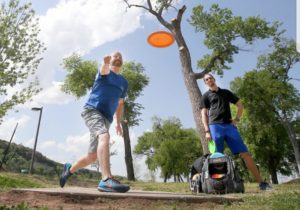 After being bit by the disc golf bug, my brother and I introduced the sport to my father and younger brother who both took to the sport naturally. I’m sure my dad looks back fondly on those first 6 months of playing together when he could throw farther than his sons, but now two of us play professionally and can regularly crush 450 foot drives. My dad has settled into an age-protected amateur division that many say has the most fun. Disc golf has become a family event and it’s a guarantee that if we are in the same city together that we are meeting at the disc golf course.
After being bit by the disc golf bug, my brother and I introduced the sport to my father and younger brother who both took to the sport naturally. I’m sure my dad looks back fondly on those first 6 months of playing together when he could throw farther than his sons, but now two of us play professionally and can regularly crush 450 foot drives. My dad has settled into an age-protected amateur division that many say has the most fun. Disc golf has become a family event and it’s a guarantee that if we are in the same city together that we are meeting at the disc golf course.
 Since I started playing disc golf in 2007, the sport has seen impressive growth and bold new milestones. In 2007, the world distance record was 820 feet, a record that had stood untouched since 2002. The current world record is 1108 feet, set last year when two players (one of which will be playing our annual event here in Waco) broke the 1,000 foot barrier. The sport has had numerous impressive shots show up on ESPN thanks to widespread live video coverage of disc golf events. Disc golf tournaments continue to grow in size and scope with some reaching payouts of $100,000 and hosting 1,000 disc golfers from around the country. It is now common and expected by the disc golf community for major tournaments to be covered by professional media groups. We have worked hard locally with the help of the city and countless volunteer hours to grow our profile and course quality to get to the point where we can host an event with the national circuit, dubbed The Disc Golf Pro Tour.
Since I started playing disc golf in 2007, the sport has seen impressive growth and bold new milestones. In 2007, the world distance record was 820 feet, a record that had stood untouched since 2002. The current world record is 1108 feet, set last year when two players (one of which will be playing our annual event here in Waco) broke the 1,000 foot barrier. The sport has had numerous impressive shots show up on ESPN thanks to widespread live video coverage of disc golf events. Disc golf tournaments continue to grow in size and scope with some reaching payouts of $100,000 and hosting 1,000 disc golfers from around the country. It is now common and expected by the disc golf community for major tournaments to be covered by professional media groups. We have worked hard locally with the help of the city and countless volunteer hours to grow our profile and course quality to get to the point where we can host an event with the national circuit, dubbed The Disc Golf Pro Tour.
 Starting Wednesday March 15th, the best disc golfers in the world will descend upon Waco to challenge the bEast and compete for large cash purses. Ryan Draper and the Waco Disc Golf Association have been working for years to get to this point and much planning has been done to make this an amazing event for both disc golfers and spectators. The event kicks off with a party/players meeting at the historic Hippodrome theater, and play for the professionals will begin Thursday morning at Brazos Park, and finish Saturday with the lead pro ladies card teeing off at 9:30 am and the pro men’s card teeing off at 2pm. Spectators will be able to win raffle prizes daily just by coming out. There will be a pub crawl with a $100 prize starting Wednesday night at 7pm and finishing Friday night at 7pm at our party on the Suspension Bridge. Live local music, vendors set up on the bridge, food trucks, glow-in-the-dark disc golf, and so much fun will be happening at Indian Springs Park and it’s all free and open to the public.
Starting Wednesday March 15th, the best disc golfers in the world will descend upon Waco to challenge the bEast and compete for large cash purses. Ryan Draper and the Waco Disc Golf Association have been working for years to get to this point and much planning has been done to make this an amazing event for both disc golfers and spectators. The event kicks off with a party/players meeting at the historic Hippodrome theater, and play for the professionals will begin Thursday morning at Brazos Park, and finish Saturday with the lead pro ladies card teeing off at 9:30 am and the pro men’s card teeing off at 2pm. Spectators will be able to win raffle prizes daily just by coming out. There will be a pub crawl with a $100 prize starting Wednesday night at 7pm and finishing Friday night at 7pm at our party on the Suspension Bridge. Live local music, vendors set up on the bridge, food trucks, glow-in-the-dark disc golf, and so much fun will be happening at Indian Springs Park and it’s all free and open to the public.
The best disc golfers in the world will be testing their skills on one of the most challenging courses in Texas. The bEast offers scenic views while testing golfer’s abilities and mental game. The front nine features many long, demanding holes with out of bounds flanking every fairway. Players with the right skills will have the opportunity to be aggressive and throw bomb shots, or to rack up out-of-bounds penalties that can sink a good round. The back 9 holes are the inspiration (or frustration) behind the namesake of the course, the bEast. Each hole has been carefully carved out of thick woods by master course designer Joey Harrell, a Texas legend and hall of fame member, to offer players the opportunity to play it safe and stay in the fairways, or to be aggressive and risk the rugged, unforgiving rough that every hole has awaiting players.
I would like to extend an invitation to you to come out and experience our event. If you have ever been curious, this is the time and place to see what disc golf is all about. If you decide you’d like to try it out, you can find me on Facebook and I’d be happy to show you our courses.
 Cameron Frymark is a professional disc golfer, student at Tarleton University, and warehouse supervisor at Preferred Medical. Cameron and his wife Tara live downtown with their fat and happy Chihuahua, Butters.
Cameron Frymark is a professional disc golfer, student at Tarleton University, and warehouse supervisor at Preferred Medical. Cameron and his wife Tara live downtown with their fat and happy Chihuahua, Butters.
Whether it’s playing trumpet in the “Friday Band” at MCC, or riding with the Waco Knight Riders, or an afternoon playing with the Waco Disc Golf Association, one of the wonderful things about Waco is that there are lots of ways to find community here. Where do you find community in Waco? Would you be interested in writing about it? If so, let us know. Email [email protected]. If you have an idea for a post. You could be seeing your own picture on this page!
by Emily Mills
“What do you do?” This is always the hardest question for me to answer. When I lead with: “I work with people in the commercial sex industry,” most people get wide eyed and bolt. The safe bet is, “I run a non-profit in Texas, we share the love of Christ with women in the commercial sex industry.” IF they stick around, I can get into the meat and marrow of Jesus Said Love. “Sex” usually throws people off and “Jesus Christ” is merely another taboo in social settings. I’m often at a disadvantage straight out of the gate. Even after the words come out, a typical response in this meet-and-greet scenario, usually by my male friends, goes something like, “So you hang out with strippers? How do I get that job?” or “It’s not everyday you meet a stripper minister.” (hardy, har, har).
Well, it’s also not everyday I’m on the phone doing breathing exercises with a woman in complete dissociation and total terror because she’s in an altered state. And it’s not everyday I hear a new friend casually recount that she was sold for sex by her parents starting at the age of 5. It’s not everyday another friend becomes paralyzed by the gang rape that took place in her club when she was “off the clock.” It’s not EVERY day, but it is many days.
My everyday is loaded with the weight of calling, as each of their stories act as lead that keeps me grounded. Their stories remind me that what isn’t my EVERYday is someone else’s. When these stories are your everyday, the weight becomes crushing without the community, the Body, the fellowship of suffering and grace. What do I do? What will we do?
We will make ART. We will tell the STORY. We will carry FIRE. We will carry a blazing “Wild Torch.”
Wild Torch is an annual fundraiser for Jesus Said Love that uses the visual and performing arts to share stories of women who have been impacted by the commercial sex industry, and the hope they’ve found on the other side. It’s an experience like no other.
It’s not everyday Tony nominated, Elizabeth Davis performs on a Waco stage, delivering a heart pounding monologue bringing an ancient narrative to modern context.
It’s not everyday you get to meet one of the “top 10 emerging artists from Austin” whose heart for Waco and the arts beats strong. An artist who looks like a surfer, but paints like mad with a broom like brush; the nephew of renowned sculptor Conway “Jiggs” Pierson. Ty will offer an original piece of work for auction at Wild Torch. (For those who love art and the creative process, listen to Ty here: http://therightspaceshow.com/#/ty-clark/ )
It’s not everyday I’m getting a haircut and become moved by the hair in a painting on the wall. Salon Asylum is no art gallery, but it’s owner is the sister to oil painter, Samuel Shelton. Sam is a Clifton based classic painter producing highly detailed and life-like work who has offered a rendering of “the woman at the well” for auction at Wild Torch.
And it’s surely not everyday you meet a near famous fabric artist who grows mushrooms to create her own natural dye. A fabric artist who has clothed Antonio Banderas, Jack Black, Catherine Zeta-Jones, and Anthony Hopkins. An artist who has received an Ariel nomination (Mexico’s equivalent to the Oscars!). Roccio Ramirez Landoll is an unknown Waco treasure whose heart and one particular exhibition (to be displayed at Wild Torch) reflects the stories of assaulted, abused, and even trafficked women.
You should also know, it’s not everyday I get to sing the stories, so deep inside, on a historic stage alongside my partner and beloved husband, Brett. We will perform with our overqualified band of ragamuffins and The Union Revival at Wild Torch.
 It may not be everyday … but it will be a day you don’t want to miss April 10th, at the Waco Hippodrome. Tickets and sponsorships are on sale at www.wildtorch.com.
It may not be everyday … but it will be a day you don’t want to miss April 10th, at the Waco Hippodrome. Tickets and sponsorships are on sale at www.wildtorch.com.
This year we are teaming up with The Art Center of Waco and offering a WILD TORCH PREVIEW AND POP UP SHOW FOR FREE!! Thursday, March 16th from 5-7 p.m , 1500 Columbus Ave. Small bites provided by Milo Provisions and mimosas by Luna Juice Bar. Come MEET these not-so-everyday artists, Ty Clark and Samuel Shelton; experience their work, see the Jesus Said Love headquarters and our storefront, Lovely Enterprises (a social enterprise that is currently creating jobs for women).
All are welcomed to come and carry fire with us!
 Emily Mills received her B. A. in Communications from Baylor University. While at Baylor, Emily participated in various opportunities to serve the marginalized and lead worship. This began her passionate pursuit to “put feet” on the songs she was singing. In 2003, while leading worship at a conference for women exiting the sex industry, these two worlds collided and Jesus Said Love was born. Emily continues to lead worship around the country with her husband, Brett. They have three children: Hattie, Lucy and Gus.
Emily Mills received her B. A. in Communications from Baylor University. While at Baylor, Emily participated in various opportunities to serve the marginalized and lead worship. This began her passionate pursuit to “put feet” on the songs she was singing. In 2003, while leading worship at a conference for women exiting the sex industry, these two worlds collided and Jesus Said Love was born. Emily continues to lead worship around the country with her husband, Brett. They have three children: Hattie, Lucy and Gus.
The Act Locally Waco blog publishes posts with a connection to these aspirations for Waco. If you are interested in writing for the Act Locally Waco Blog, please email [email protected] for more information.
By Hermann Pereira
When I entered into the education field 10 years ago I thought to myself, “Next year I will find a real job…” I had studied business administration at Stephen F. Austin and thought the corporate world was where I wanted to spend my career. We had moved to Waco and I figured teaching would be easy. Boy, was I wrong! Being an educator was challenging and rewarding and I was hooked early on. I followed my wife into the profession after I saw the influence she had in the classroom and as a coach. I wanted to do the same for students that looked like me and ones that came from blue collar families like me as well. I found my motivation to impact young people’s lives early in my teaching career at West ISD. Then, as I began working at Connally ISD, I realized my motivation to impact others needed to be broader. That led me to Baylor University where I earned my Master’s degree in Educational Administration.
I have been blessed to lead the team at Connally Career Tech for the past year and it has been one of the most rewarding things I have ever done. We have had success in a short amount of time and I think that all boils down to a few key ingredients: motivation and partnerships.
Motivation is key
More than three years ago Connally ISD decided to think outside of the box. They created Connally Career Tech Early College High School. Leaders at Connally were motivated to serve the students at Connally ISD in a unique way because the reality is not every student has the desire to attend a 4-year university. We are a school within a school model, which means students can experience high school sports and activities and attend college classes. One important feature of our campus is that all tuition, books and supplies are free to the families so cost is not a barrier to students. All students from Connally High School can apply to be a part of our campus if they have the desire to enter into one of our career clusters. Those clusters consist of Construction, Computers, Criminal Justice, Drafting, Healthcare, Manufacturing, Technology, Transportation Technology or Visual Communications. Once students show an interest in these fields we educate them on what types of opportunities they may have if they study one of these fields.
Students are learning hands on career skills in a certain field as well as soft skills that will help them to become the very best in their chosen industries. We have seen that once students begin working in an industry for which they feel a passion, their motivation will push them to achieve more than they would have ever imagined. Students receive extra support and guidance in a “small school feel” from teachers and faculty due to the Early College High School (ECHS) model that we follow. Some students will finish with college hours in a career field, some will complete certifications or an Associate’s degree in a certain field. Either way they are realizing that these opportunities are generation changers.
Partnerships
Connally ISD is fortunate to be part of the greater Waco area which is filled with people, companies, higher ed institutions and other organizations that are ready and willing to partner with the efforts of all schools. For schools like ours, that make college hours available to students, it all begins with our higher education partners. Texas State Technical College was the first college partner that opened its doors and made its programs available to our students. On TSTC’s Waco campus, Connally Career Tech students are able to earn certificates and Associate’s degrees in high demand technical fields. Our students are able to learn from the best professors and are able to experience top notch facilities in these different fields. Our focus on career readiness also led us to a partnership with McLennan Community College that will kick off this upcoming fall. With this new partnership Connally Career Tech students will be able to choose from a number of public service careers. Our students will have the opportunity to earn certificates and possibly Associate’s degrees in industries such as health care and emergency service fields. Recruiting is almost over for next school year and we have had a great deal of interest from families about our new career offerings.
In a short amount of time we have found that members of the community are eager to partner with us to help create more well-rounded, career driven students. So far we have relationships with large companies, small local businesses, and nonprofits who are providing mentoring, opportunities to serve those in need, career guidance, supplies for clubs and activities, and paid internships. These key relationships have been fostered through our active advisory board at Connally Career Tech.
In my conversations with students I try to stress to them that in a few short semesters they will be walking the stage as Connally ISD graduates and we all will be proud of them. Students are motivated to finish high school, but what I emphasize is that they need to make sure they are college and/or career ready before they shake my hand on stage. Our career driven campus serves students in our school district well, but it is also something that could be replicated. Hopefully in the coming years other local school districts will choose to embark on a similar journey, and when they do Connally Career Tech will be there to partner with them.
 Hermann Pereira is the Principal of Connally Career Tech Early College High School and has been in education for 10 years. He is a Houstonian who roots for all Houston sports teams but has called Waco home for the past decade. He has been married to Kristi for 13 years and has two children, Hudson who is 8 years old and Ruby who is 5 years old.
Hermann Pereira is the Principal of Connally Career Tech Early College High School and has been in education for 10 years. He is a Houstonian who roots for all Houston sports teams but has called Waco home for the past decade. He has been married to Kristi for 13 years and has two children, Hudson who is 8 years old and Ruby who is 5 years old.
by Joshua Carney
Cast:
- Reverend Dr. Leslie “I AM” King of 1st Presbyterian Waco, hereafter LK
- Her trusty sidekick, associate pastor Dee Dee Porter Carson, hereafter DDPC
- Erin Conway “Twitty,” pastor of 7th and James, hereafter Twitty
- Tim Jarrell, pastor of Austin Ave. Methodist, hereafter TJ (of course)
- Sharron “Bobby” Cox, Assistant Rector of St. Paul’s Episcopal, hereafter Skipper
- Austin Nickel “Back,” SAWL at First Lutheran, hereafter Saul
- Josh Carney, amateur theologian and licensed Baptist or to quote A River Runs Through It backwards, “a Methodist who can’t read.” hereafter JC
Setting:
A rainy November day at Dichotomy, the surprisingly swanky post-post modern coffee shop located in the cultural epicenter of Texas, Waco.
DDPC has called a meeting of Waco’s finest downtown religious zealots to hash out what the ecumenical bunch will do with Waco and Lent, everyone’s favorite Christian holiday ever since they collectively read Kafka on their pastoral getaway.
_____
DDPC: Thanks for coming everyone. Did you get a drink? Do you want a drink?
Skipper: I already ordered, a 30-30 with a dash of Commonwealth, skinny, with a side of caviar.
Twitty: Wait, what did you order?
Skipper: You’ll read about it in Harper’s later this month. It’s all the rage with the Anglicans.
JC: I see they do alcohol here as well. How much do you suppose a Miller Lite is?
LK rolls her eyes visibly irritated by JC, tries to recall who invited him in the first place
DDPC: So let’s start by talking about what we liked about last year.
LK: It was great. It was all great. Carney was suspect, but other than that it was great.
Twitty: Remind me what we did last year?
TJ: Rotated pastors at churches. Small liturgy and lunch after.
Twitty: Oh yeah, the food trucks. Did people like that?
Saul: Yes, the ones that came did.
Skipper: Yes our people liked it, but we were hoping to have Diamondbacks cater this year. Dee Dee, look into that. will you?
LK: We need something big this year. Something Waco! Something the kids have never seen before!
Saul: Something like Chip and Joanna big.
LK: No, not that big, we can’t afford that.
TJ: How about Steve Martin, isn’t he from Waco?
Twitty: I’m not sure he’s religious.
LK: Twitty, good. I like what you’re thinking. More of that.
Twitty surprised at how well his contribution is received.
Twitty: Oh, well in that case, what about RG III, or Jessica Simpson she’s from Waco … or was that her Grandma? I can never remember.
LK: Too much.
Saul: What about Jennifer Love Hewitt? We could do Hewitt comes to Hewitt.
JC: What is the point of this again?
DDPC: Carney, good question. Let’s revisit that. What are we trying to do?
Skipper: I thought we were trying to connect downtown Waco people with Lent on Wednesdays during their lunch hour.
LK: Yes, we want to make Lent relevant again. Someone make that a hashtag.
DDPC: So let’s start with place. Where are we going to have this?
JC: Let’s rent McLane Stadium.
Saul: Someone already did that.
Twitty: What about Scruffy Murphs?
LK: Wrong side of town.
JC: They do Miller.
DDPC: Is that still open?
TJ: What about Barnett’s?
LK: Too small. I’m expecting millions.
DDPC: Hippodrome?
LK: Bam! That’s it. I’ll get my guys on that.
DDPC: What about speakers?
Twitty: What do we want the speakers to do?
TJ: Well, I’ve recently heard of this program called The Moth. It’s a podcast. People tell their stories.
LK: Good TJ, I like this. Tell me more.
TJ: Well they tell their stories and people love it. The kids go crazy for these stories.
Twitty: These stories. What’s so great about them? Are they about sex, drugs and rock and roll?
Pensive look crosses TJ’s face as he recalls his experience with The MOTH podcast
Slowly … TJ: hmmm… for instance … one story was about a blind guy at a rattlesnake convention in TX.
LK: I love rattlesnakes, and the text from the second week of Lent is that one about snakes biting Israelites. This is predestined.
JC: I didn’t think PCUSA was that kind of Presbyterian.
LK: Dee Dee, make a point to take Carney off the email thread next year.
Saul: So, The Moth @ the Hippodrome on Wednesdays during lunch. What time will this start?
JC: I don’t think you can use The Moth, you’ll get sued for copyright violations.
DDPC: Yes, Wednesdays at noon. Get there before noon and you get 10% off of your lunch order. The speaker will speak for 10-15 minutes and we will rotate who does the short reflection after.
Skipper: Reflection? What kind reflection?
DDPC: I’ll send you something to look at. Something on silence.
Saul: What dates?
DDPC: Ash Wednesday is March 1st, but everyone will be gone on the 8th for spring break. So let’s start the week after. The dates will be March 15, 22, 29 and April 5.
Twitty: We still don’t have any speakers.
TJ: Who can do Moth type stories?
LK: Who do the kids love over at Baylor?
JC: They all love Tran.
LK: Who?
JC: The religious/ethics guy. He’s from Duke.
LK: Good, let’s do Tran. Who else?
Skipper: What about the lady who does toddler time at the public library? She is the storytelling guild. Vivian someone?
DDPC: Miss Vivian? My kid loves her!
JC: My kids love her!
Skipper: All kids love her.
LK: Good, let’s do Vivian. Who else?
Twitty: I’ve got this guy at 7th. Listening to him tell stories is like skating on butter. Bob Darden.
Saul: Skating on butter?
LK: Tell me more.
Twitty: He mentored Garrison Keillor and he was a pioneer of narrative theology.
JC: Wait, who is this?
Twitty: Just go with it.
LK: Good, let’s do Darden. Who else?
DDPC: What about Lyndon Olson?
LK: Good Dee Dee.
Skipper: Who’s Lyndon Olson?
DDPC: Ambassador Lyndon Olson brokered the Geneva Convention, defeated Hulk Hogan in WrestleMania 7 and nailed Jell-O to a tree.
LK: And that’s just the stuff that wouldn’t fit on his C.V.
Saul: Sounds like a winner.
DDPC: We need to market this. Carney your church is full of young hipsters. Do you have anyone in the design department?
JC: Yes, Nathaniel Mosher of peopletownart.com.
LK: We need to advertise this. Where do people look to get Waco info?
Twitty: What about that Act Locally Waco blog? I think Ashley Bean Thornton does that. Does anyone know her?
JC: I know her. I’ll ask her. What should I say?
LK: Just give her the information.
JC: That’s too much noise. I need something creative. Something people will read. What about a mock up of this conversation?
LK: No one will read that.
JC: Yes they will.
LK: OK smart ass, why don’t you do the write up then.
JC: Maybe I will.
DDPC: OK, great meeting. Carney when you do the write up, make sure you include the flyer.
Lights Fade
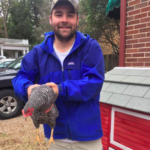 Josh Carney is the lead pastor at UBC in Waco. Under his leadership attendance has gone down. Josh has not written any books and no one has ever asked him to speak.
Josh Carney is the lead pastor at UBC in Waco. Under his leadership attendance has gone down. Josh has not written any books and no one has ever asked him to speak.
By Louise Henderson
When I mention that I am a part of a trail riding group, most people are not sure what trail riding is really about or what a trail riding group does. For most people the first responses is “Oh, you ride horses and wear boots and a huge Texas belt buckle covered with rhinestones!” Well, some of that is true! But, being a part of the Waco Knight Riders these past two years has given me a new perspective about what trail riding is all about. It’s about being a cowboy or cowgirl; it’s about family and community.
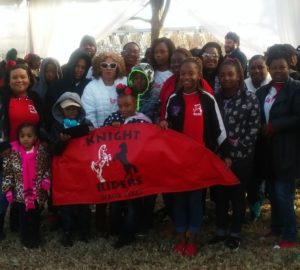 Yes, like you might expect, you will see people who wear a large white cowboy hat and a red button down shirt with the name “Big L” on it. But what you might not know is that thanks to the Waco Knight Riders, you can find Big L and the rest of us pretty much all over Waco doing some type of community service. We have been known to do anything from raising money to prevent domestic violence, to wrapping toys to give away for Christmas, to visiting those in the hospital. If you look, you can find a Waco Knight Rider giving back to the community.
Yes, like you might expect, you will see people who wear a large white cowboy hat and a red button down shirt with the name “Big L” on it. But what you might not know is that thanks to the Waco Knight Riders, you can find Big L and the rest of us pretty much all over Waco doing some type of community service. We have been known to do anything from raising money to prevent domestic violence, to wrapping toys to give away for Christmas, to visiting those in the hospital. If you look, you can find a Waco Knight Rider giving back to the community.
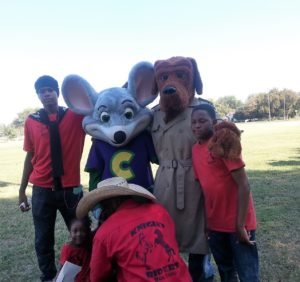 Usually we are in the East Waco area hanging out in the field in the iron steel wagon talking about club business. We might be discussing what our next community project will be. Or we might be talking about how we are going to work with and support other local trail ride groups like “Most Wanted” or “Waco Is My City Riderz.” For example, last December we worked with the Waco all Female club who had a dance just for kids. Our outreach is not limited to just here in Waco. We have traveled to other cities all over Texas, Louisiana, and Mississippi. It’s funny. When a Waco Knight moves, we tend to sprout up where ever they go like we have in Dallas and Louisiana.
Usually we are in the East Waco area hanging out in the field in the iron steel wagon talking about club business. We might be discussing what our next community project will be. Or we might be talking about how we are going to work with and support other local trail ride groups like “Most Wanted” or “Waco Is My City Riderz.” For example, last December we worked with the Waco all Female club who had a dance just for kids. Our outreach is not limited to just here in Waco. We have traveled to other cities all over Texas, Louisiana, and Mississippi. It’s funny. When a Waco Knight moves, we tend to sprout up where ever they go like we have in Dallas and Louisiana.
I think that is what drew me to this group, their activism in the community. I appreciate that no one person is bound to just wait on the rest to go and do anything. Each member is encouraged to pursue something in the community to live out our motto to GIVE back.
 As I was writing this I started wondering what the attraction to this club is. I mean, yeah, the button down pressed shirt with the two horses is cool, but what makes others want to be a Waco Knight Rider?
As I was writing this I started wondering what the attraction to this club is. I mean, yeah, the button down pressed shirt with the two horses is cool, but what makes others want to be a Waco Knight Rider?
So, I asked a few of the club members what made them want to join and be a part of this group. DeeDee, who just joined the group not too long ago, mentioned the high standards and moral character required to join and continue as a member. She said, Big L, Donnell, Rita and the rest of the members came to West during the big explosion all in their red shirts passing out water, and blankets, and food. “That’s what drew me to them and how they conducted themselves no matter where they are.” Another thing I like, she said, is that she always feels comfortable talking and laughing with “the Three Wise Women,” Rita, Darlene and Donnell. “To me they are the mothers and enforcers of the group with Big L as President and Cowboy Dre planning the next big thing to do as far as community.” This community riding club is always out participating in parades, donating school supplies, participating in the MLK March every year. You see the Knight Riders all over Waco being a part of the activities in Waco. There aren’t too many things we haven’t participated in as far as civic service. We held a day for youth to learn about the first black Buffalo Cowboy and even taught the young people how to ride and to become the next Trail Boss which is a big deal for trail riders.
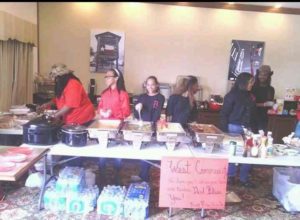 For me, I came from Dallas six years ago. My Children and I really didn’t know anyone here. I saw through a mutual friend how the Waco Knight Riders always had kids with them no matter where they posted pictures. I thought that is what I want to be a part of, and that’s how I want my family to be active in the community together.
For me, I came from Dallas six years ago. My Children and I really didn’t know anyone here. I saw through a mutual friend how the Waco Knight Riders always had kids with them no matter where they posted pictures. I thought that is what I want to be a part of, and that’s how I want my family to be active in the community together.
And so, two years later, I have been in a group where I have traveled to Houston, Bryan, Hearne, and other places to see other trail ride families and make new friends. We all travel together. Don’t get me wrong. Like most families we have our bumps and hardships, but I have learned that you can pick your family. You can pick the ones that you call your brother or sister. I have been privileged to call these people my family these past two years! I have also learned about myself. I have learned that I have the capability to be whatever I want to be with the confidence and support of those that love me. Even my daughters have learned what it means to wear a Knight Rider shirt to school. When their friends ask about riding club they can say it is more than just about horses, it about the love of our community and being active.
 Louise Henderson has four daughters — one at Texas A&M (Elizabeth), two at University High School (Rachel and Naomi) and one at Cesar Chavez Middle School (Rebecca) — and puppy named Rico. She and her family have lived in Waco for six years and are very active in our community. She is a member of the Junior League of Waco, NAACP of Waco, and Waco Knight Riders. She graduated from McLennan Community College with an Associate’s Degree in Child Development and is working towards a Bachelor’s degree in Child and Family studies at Tarleton State University. She loves Taco Tuesday at Rosas Café and volunteering in Waco. She is the founder of the Central Texas Divas, a social club for women and young girls to empower and educate about them about self-improvement and our community.
Louise Henderson has four daughters — one at Texas A&M (Elizabeth), two at University High School (Rachel and Naomi) and one at Cesar Chavez Middle School (Rebecca) — and puppy named Rico. She and her family have lived in Waco for six years and are very active in our community. She is a member of the Junior League of Waco, NAACP of Waco, and Waco Knight Riders. She graduated from McLennan Community College with an Associate’s Degree in Child Development and is working towards a Bachelor’s degree in Child and Family studies at Tarleton State University. She loves Taco Tuesday at Rosas Café and volunteering in Waco. She is the founder of the Central Texas Divas, a social club for women and young girls to empower and educate about them about self-improvement and our community.
Whether it’s playing trumpet in the “Friday Band” at MCC, playing board games at King’s Landing, or riding with the Waco Knight Riders, one of the wonderful things about Waco is that there are lots of ways to find community here. Where do you find community in Waco? Would you be interested in writing about it? If so, let us know. Email [email protected]. If you have an idea for a post. You could be seeing your own picture on this page!
By DeShauna Hollie
Middle school scripts
High school haiku’s
Rite of passage puppet shows
Words occasionally slipping out
Fitting themselves together
Largely without me knowing
Forming into creative pieces,
That even I was surprised by
At least…In the beginning
Process mattering so
Much more than product
That sacred place
Between vulnerability and art
Do you know those things that you take for granted as a kid, but as you grow up and go through all of those phases of development that help you figure yourself out? Do you ever think about that instance when you discovered all the gifts that your parents and caregivers have given you, those gifts that you are only now beginning to appreciate? Do you know what I’m talking about?
When I sat down to write this blog I started to think about why I write poetry or why I’m so interested in art, and I remembered being in first grade. I had a pretty lucrative tracing business that year. My classmates often asked me to trace pictures for them from coloring books. They paid me in blow pops and pencils. I also thought back to ninth grade, when I learned how to write a haiku. I’ve been writing them ever since then, and although I don’t trace as much as I used to I do still find myself doodling on meeting agendas (it helps me listen) . Until a few years ago, it never occurred to me that those artistic tendencies were a gift from my father.
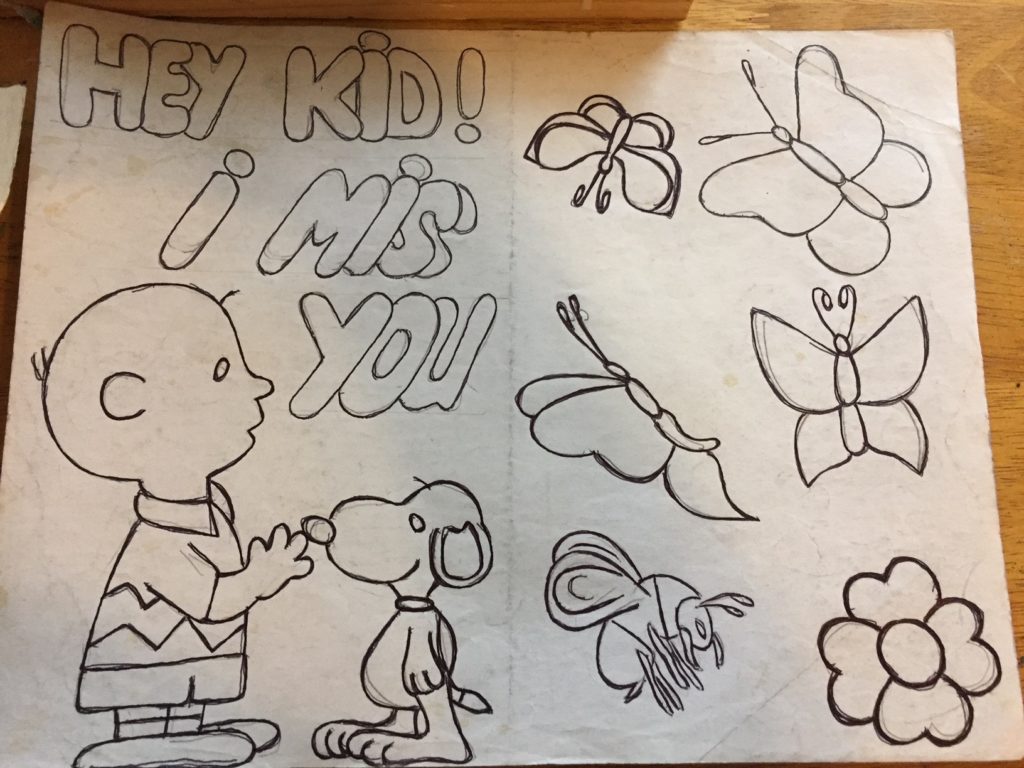
My father made us handmade cards for our birthdays and every holiday. They were personalized to our personalities and to our hopes and dreams. They often included cartoon characters from pop culture interwoven with words of wisdom, psalms and poetry. I say cards but usually it was a packet of cards and drawings for birthdays and every major holiday.
Although I don’t remember it, I’m sure I must’ve learned how to trace from him. He died a few years ago but I have quite a few of his stencils that he used when he made our cards. One of the things that he did for work was that he also painted signs on buildings, usually lettering on the sides of walls. So sometimes when I am walking around town I’ll glance up at the words on the side of a building and see his name.
It’s kind neat to have that reminder of his work and that reminder that art is very much entwined in my culture and in who I am. I’m grateful to have the opportunity to share why art is in my life.

Get Involved!
- Every LAST SATURDAY from 7-9pm King’s Landing hosts a Monthly #DrinknDraw event where artists are invited to gather together to draw, have a drink, and enjoy the camaraderie of community creating collectively!
- Central Texas Artist Collective will be having its first quarterly public meeting on Sunday March 12 at Maker’s Edge from 3-5pm. If you are an artist in the area looking to connect with other creatives, volunteer with arts events, learn about exhibiting/vendor opportunities, mark your calendar!
- Waco Poets Society hosts open mic every Second Saturday 7pm @ Rufi’s Cocina and every Third Thursday 7pm @ Tea2Go :: open to poets, spoken-word artists, story-tellers, musicians, singer/songwriters, and other performance art/creative expression
- #CTAC will be having their next #Ekphrasis planning meeting Saturday April, 1, 2017 (location TBD) open to anyone interested in volunteering with the planning process or any of the events along the way to prep for the exhibit opening in the Fall, email: [email protected] for more info.
- Creative Waco has a Top 10 Creative Ways to Engage in Waco over Spring Break, and a line-up of summer camp options for the blooming young artists in your life!
- The Art Center of Waco has upcoming exhibits, summer camp options, and classes for adults and youth…visit their website to explore the options!
- And don’t forget to check out the Waco Symphony, Waco Civic Theater, Brazos Nights, Art on Elm coming up April 7-8th, Food Truck Showdown on Saturday April 1st, and many more ways to stay inspired and creatively fed in Central Texas!
 DeShauna Hollie is local poet who loves the process of writing poetry and creating art much more than the end product. Sometimes for fun she records poetry for practice. She also loves creating with other people, for her art is very much a community process.
DeShauna Hollie is local poet who loves the process of writing poetry and creating art much more than the end product. Sometimes for fun she records poetry for practice. She also loves creating with other people, for her art is very much a community process.
The Act Locally Waco blog publishes posts with a connection to these aspirations for Waco. If you are interested in writing for the Act Locally Waco Blog, please email [email protected] for more information.
By Madison Albee
Part of the mission of McLennan Community College is to engage, educate, and enrich the community. To achieve this, we provide services that ensure student success. Not only is academic success challenging, but students may also experience a variety of personal, social, emotional, and adjustment issues that require assistance.
One very important (and little-known) program we provide is free counseling. The MCC Student Counseling Center provides free psychological counseling for students who are enrolled at MCC, as well as University Center students who attend classes through partner universities at MCC. MCC licensed professional counselors and counseling interns from the clinical mental health counseling program at Tarleton State University are available to help students overcome their challenges. Session lengths vary depending on the student’s needs.
Dr. Ryan D. Foster, director of MCC’s Student Counseling Center, said the Counseling Center serves more than one purpose: “The SCC’s purpose is twofold: (1) to serve students and families of students at MCC and University Center partner schools with comprehensive counseling and related services and (2) to provide opportunities for graduate students in the Clinical Mental Health Counseling Program at Tarleton State University with supervised clinical training and experiences.”
Individual Counseling:
One type of counseling the Student Counseling Center provides is individual counseling. This is a one-on-one meeting with a licensed professional counselor or licensed professional counselor-intern. Individual counseling is designed to focus on short-term goals in order to facilitate students’ college success and adjustment. The number of counseling sessions a student will receive varies and is determined by the nature of the concern, and an agreement between the student and counselor. Some of the most common concerns for college students seeking counseling services include but are not limited to:
- Feeling stressed out or anxious
- Feeling overwhelmed by school workload, work, family responsibilities
- Feeling sad, depressed and/or low mood or energy
- Difficulty adjusting to a recent change
- Difficulty in making decisions or unsure of the future
- Relationship issues
- Feeling isolation from others
- Grief issues
- Sleep issues – sleeping too much or too little, difficulty initiating or maintaining sleep
- Concerns about alcohol/drug use
- Eating disorders
- Trauma – recent or past
- Thoughts of self-harm or harm to others
Crisis Counseling:
Another type of counseling the center provides is crisis counseling. The most common concerns that may warrant a crisis referral include but are not limited to:
- Concerns about my ability to keep myself safe
- Having a current plan to attempt suicide
- Having taken recent steps to end my life
- Having a strong desire to physically hurt or harm someone else
- Experiencing sexual assault/harassment/relationship violence
- Hearing voices or seeing things other people do not
- Experiencing emotional distress which prevent my ability to meet my daily responsibilities.
In crisis situations similar to those above, students are advised to call 911 if it is after hours, and they are not on the MCC campus.
Dr. Foster said he has seen students grow during their time spent at the counseling center. “I have seen clients of our counseling center develop healthy emotional boundaries, coping skills, self-awareness, and insight into their own intrapsychic and interpersonal process,” he said. “Many of our clients benefit from the emotional and personal growth that they achieve through counseling here.”
It is important for students to be aware that MCC has services available to them should they need it. Students may schedule an appointment by phone by calling 254-299-8210, sending an email request for an appointment to [email protected], or by coming by the counseling office, located in the Wellness & Fitness Building, Room 101.
For more information, go to http://www.mclennan.edu/counseling/crisis-counseling.
 Madison Albee is a senior at Baylor University from Fort Worth, Texas. She is studying journalism/public relations with a concentration in marketing and is graduating this coming May. Currently Madison works for MCC as a public relations intern in the marketing and communications department. She is also the public relations assistant for Luca Magazine.
Madison Albee is a senior at Baylor University from Fort Worth, Texas. She is studying journalism/public relations with a concentration in marketing and is graduating this coming May. Currently Madison works for MCC as a public relations intern in the marketing and communications department. She is also the public relations assistant for Luca Magazine.
The Act Locally Waco blog publishes posts with a connection to these aspirations for Waco. If you are interested in writing for the Act Locally Waco Blog, please email [email protected] for more information.
By Jasmine Wise
I love the Waco area and it’s hometown feel. I love that I can shop in national chains and local stores right next to each other. I love that I can be engaged in the community at any level I choose. I love that people know each other, like really know each other. I love that people here love Waco and collectively want to see this city flourish. I love that there are individuals in their neighborhoods doing just that. They are creating spaces to improve the areas around them. I am blessed to know and be able to connect with these people. Each one of them sees a need and works to fill it to the best of their abilities.
Waco and its’ surrounding area are unique places. We have three universities yet a largely uneducated population; plenty of new businesses yet over 50% of our population is in poverty. Waco is changing rapidly in population and size. On the other hand, parts of the community are not changing and standing still. Waco, like every other city, is flourishing in many areas yet has aspects that can be improved. The individuals I mentioned above are attempting to create ways to connect their efforts to enhance Waco. They are asking some serious questions to do so effectively. How do we create policies, services, and community initiatives that positively affect different populations in our area? How do we even know what policies, services, and community initiatives are needed? In addition, how do we gain insight from within the community?
 I am privileged to work at the Center for Community Research and Development (CCRD) that believes its mission is to help inform the answer to these questions and many more like them. The CCRD, established in 1979, engages Baylor faculty and graduate students in applied social research to improve the local quality of life for all residents. Over the last 38 years, the Center for Community Research and Development has helped inform local hospital/patient relationships, conducted Waco Police Department assessments, and program development for the Cooper Foundation. The CCRD is committed to making the local community an enjoyable place for all to live. You can found our more about the CCRD here.
I am privileged to work at the Center for Community Research and Development (CCRD) that believes its mission is to help inform the answer to these questions and many more like them. The CCRD, established in 1979, engages Baylor faculty and graduate students in applied social research to improve the local quality of life for all residents. Over the last 38 years, the Center for Community Research and Development has helped inform local hospital/patient relationships, conducted Waco Police Department assessments, and program development for the Cooper Foundation. The CCRD is committed to making the local community an enjoyable place for all to live. You can found our more about the CCRD here.
One of our newest initiatives in this commitment is the Waco Area Connect (WAC). The Waco Area Connect is an online survey system housed at the CCRD. The WAC is unique because it will use direct answers of people within the community to communicate to the local entities that can enact change. Our anonymous surveys cover a variety of topics concerning the Waco community. In recent years, we have asked about public health, neighborhood safety, social services, local education, and transportation issues.
The Waco Area Connect asks important questions directly linked to the community. We know that the voices come directly from our community and therefore welcome and value them. The WAC is significant because we take your answers and inform your solutions. We do not use national data of projects that have worked in other cities but use data from our city to advise change. We want our community to know they have a hand in solutions are created and handled on a local level. In addition, that their policy makers can hear from them through well informed grounded research.
The CCRD has collaborated with Prosper Waco to answer some of the questions above. Because of this, some of the questions asked will directly correlate to the goals of Prosper Waco: health, education, and finances.
The WAC is attempting to expand its reach to differing members of our local community. If you want to join your friends and neighbors in Waco- McLennan County to take occasional online surveys you can click the link below and add yourself to our registry. We value your time and would prefer you use it to engage in the community because of this we attempt to limit our surveys to two (2) surveys per calendar year. If you agree with our consent form, we will follow up to ask for your e-mail address.
Click here to access the Social Research Registry Consent Form.
It you did not get this before, I love Waco and its surrounding areas. Please help others love them by letting us know your opinions. I hope you join us on our journey to enhance an already wonderful place to live.
 By day, Jasmine Wise is a graduate student in the department of Sociology at Baylor University working on her Ph.D in Applied Sociology. While at Baylor, she works as a senior analyst at the Center for Community Research and Development. By night, she is a youth leader at Acts Church in Waco, TX. By weekend, she develops her passions for public speaking, growing churches, developing communities. She wrote her first book, “Confessions of a Sinner”, in the Summer 2015. If you want to get in contact with Jasmine, please email her at [email protected]
By day, Jasmine Wise is a graduate student in the department of Sociology at Baylor University working on her Ph.D in Applied Sociology. While at Baylor, she works as a senior analyst at the Center for Community Research and Development. By night, she is a youth leader at Acts Church in Waco, TX. By weekend, she develops her passions for public speaking, growing churches, developing communities. She wrote her first book, “Confessions of a Sinner”, in the Summer 2015. If you want to get in contact with Jasmine, please email her at [email protected]
by Liz Ligawa
Can you remember a time when you were not believed? As you think back to that time, how do you remember it impacting you? Was doubt able to sneak in and influence the credibility of your own story? Perhaps, as a response, you became a little more selective with what you shared, or at least, with whom you shared. I posed this same question to about 50 undergraduate students in a Human Diversity class where I was the guest lecturer. What we learned, as a class, of these kind of events was telling: incidents where our experiences were invalidated by doubt or unbelief began to invisibly shape how we related to others, but more significantly, we tended to wrap our truths with silence as we learned to navigate a world that had little room for our perspective.
This simple exercise I conducted with that class still resonates with me. It speaks of how one human experience can shape so many others. Although the examples shared were relatively light in nature, and were part of common childhood experiences, the impact of those incidents on the future behavior of these truth-sharers was great. I was not expecting behavioral changes to be the result of these incidents, but they were.
In our work, we speak a lot about collaboration. Our current posture toward collaboration comes from the realization that the work, and the outcomes we hope to achieve from this work, cannot happen without the collective work of many hands. In our urgency to approach the work with these many hands, however, I have observed a common forgetting (of sorts). We seem to forget that those hands are connected to people, and people function through relationships. In her book titled, Teaching Peace: A Restorative Justice Framework for Strengthening Relationships, Dr. Beverly Title alerts us to pay attention in this way. “Every relationship is valuable, no matter how insignificant it may first appear, as it is a potential window to wisdom,” (Title, 2011). Sometimes in our ambition to work, we forget that the hands are connected to people, and that it is in those people where the wisdom for the work is contained.
The Aspen Institute recently published a helpful review of community change initiatives (CCIs) over the last two decades so that the work going forward can be better informed. In their publication, the voice of relationship was also heralded as a necessary component toward change: “Comprehensive change in the most disinvested communities required effective working relationships across a multitude of community, private, and public institutions. Since poor communities had long been disconnected from outside entities, the key to sustained long-term change was to build cooperative connections,” (Kubisch, Auspos, Brown, & Dewar, 2010). In social work, we consider human relationships central to change. This is our value. So, how does this play out?
When joining the work of marginalized communities, or communities experiencing significant change, I pay attention to the role that disenfranchisement, or disconnection, has played in the life of the community. Feeling unheard is a great suffering. Not only is it difficult navigating systemic barriers that function oppressively, but it is also not the first thing that people want to talk about. Life is life, and most of us are busy just going about it. So, as I go about learning what life is like, I look for the many ways available to build the trust requisite to connect the hands to the work. Sometimes it means I show up. Sometimes it means I share. But most often, I find that trust is built on an ordinary path that many have left grown over. The path to trust is simply believing the truth that is entrusted to you. And, in the dignity of those every day moments, the work finally becomes shared, and perhaps our investments of hope fulfilled.
 Elizabeth Ligawa is a recent graduate from Truett Theological Seminary, and the Diana R. Garland School of Social Work, earning both her Master of Divinity, and Master of Social Work. Though her prized role is being a mother to her dear son, Elijah, Liz has a love for encouraging people to come together in ways that engender healthy communities. Her role as the Director of Community Engagement at Prosper Waco allows her the room to work in and among the many faces of her beloved Waco community. She may be reached at [email protected].
Elizabeth Ligawa is a recent graduate from Truett Theological Seminary, and the Diana R. Garland School of Social Work, earning both her Master of Divinity, and Master of Social Work. Though her prized role is being a mother to her dear son, Elijah, Liz has a love for encouraging people to come together in ways that engender healthy communities. Her role as the Director of Community Engagement at Prosper Waco allows her the room to work in and among the many faces of her beloved Waco community. She may be reached at [email protected].
The Act Locally Waco blog publishes posts with a connection to these Aspirations for Waco. If you are interested in writing for the Act Locally Waco Blog, please email [email protected] for more information.

